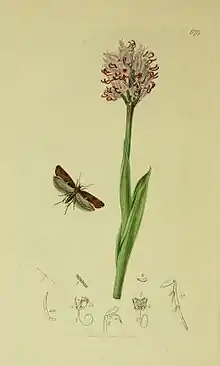| Acrolepiopsis betulella | |
|---|---|
 | |
| Illustration from John Curtis's British Entomology Volume 6 | |
| Scientific classification | |
| Domain: | Eukaryota |
| Kingdom: | Animalia |
| Phylum: | Arthropoda |
| Class: | Insecta |
| Order: | Lepidoptera |
| Family: | Acrolepiidae |
| Genus: | Acrolepiopsis |
| Species: | A. betulella |
| Binomial name | |
| Acrolepiopsis betulella Curtis, 1838 | |
| Synonyms | |
| |
Acrolepiopsis betulella (Durham tinea) is a moth of the family Acrolepiidae. It is found in most of central and western Europe. It was believed to be extinct in Great Britain, with 19th-century records from damp woodland in County Durham and Yorkshire and 20th-century records from Scotland, until a specimen was captured in County Durham in spring 2012.[1]
The wingspan is 12–14 mm. Adults are on wing in July. There is one generation per year.
The larvae feed within flowers and seedheads of Allium ursinum.
References
- ↑ "Durham tinea (Acrolepiopsis betulella) re-discovered in England!". 13 March 2012. Retrieved 27 March 2012.
External links
Wikimedia Commons has media related to Acrolepiopsis betulella.
Wikispecies has information related to Acrolepiopsis betulella.
This article is issued from Wikipedia. The text is licensed under Creative Commons - Attribution - Sharealike. Additional terms may apply for the media files.